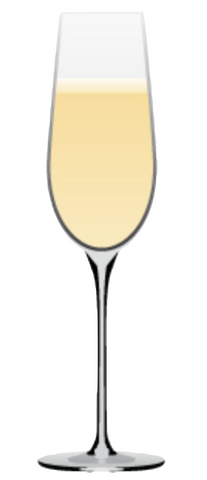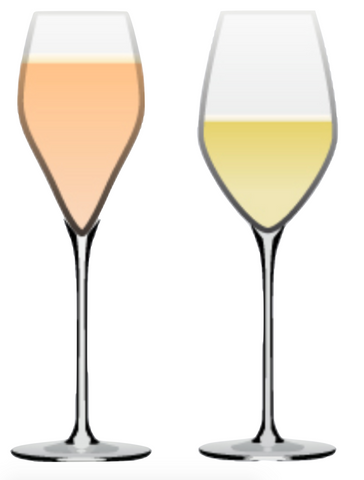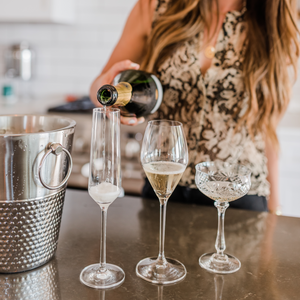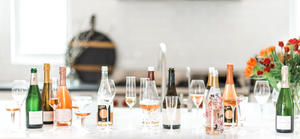

The Flute
The champagne flute was developed in the early 1700's as the preferred shape for sparkling wine as materials for stemware shifted from metal and ceramic to glass. This tall, slender shape which curves inward slightly near the lip, is designed to retain champagne's signature carbonation by reducing the surface area for bubbles to escape; too much surface area allows carbonation to fizzle out quickly. More bubbles create greater texture in the taster's mouth, and a flute's tall bowl allows for greater visual effect of bubbles rising to the top. This visual appeal is the main reason flutes are a top choice for serving bubbly. The downside, however, is that because of its narrow opening, it limits the aromas the drinker can experience. For that reason, if you are sipping on a special vintage champagne, the flute may not be the best choice for you. READ MORE ON THE FLUTE

The Coupe
Legend has it that the shape of the coupe was modeled on the breast of Queen Marie Antoinette, wife of King Louis XVI of France, but in fact the glass was designed in England over a century earlier especially for sparkling wine and champagne in 1663. Even though this story is decidedly false, the sexiness and festiveness of the glass remains. The coupe was fashionable in France since its introduction in the 1700's, and made its way in popularity in the United States from the 1930's to the 1970's. Still today, with TV shows like "Mad Men" and "Boardwalk Empire," these old-fashioned coupes are frequently being used. Now seductive as they may be, there are a few disadvantages to drinking out of a coupe. Firstly, if you talk with your hands like myself, the likelihood of spilling your tasty glass of bubbly is pretty high. Secondly, the wide bowl of a coupe does not preserve the bubbles well thus creating a flat beverage if the drinker doesn't consume their drink quick enough. So again, if you're not interesting in slurping down your bubbly fast, the coupe might not be your best choice either. READ MORE ON THE COUPE

The Tulip/White Wine Glass
The champagne tulip is distinguishable from the champagne flute by its wider flared body and tapered mouth. Some oenophiles (aka wine-geeks) prefer the tulip glass, as it permits the drinker to experience more full aromas than a flute while the mouth is still narrow enough to avoid quick loss of carbonation. Further, a lot of experts in the Champagne world are beginning to switch from a tulip to a more ‘traditional’ white wine glass shape as the bowls are even larger and the aromas therefore get much more complex and beautiful. I agree with the experts' opinions and prefer to sip my bubbly out of a champagne tulip or white wine glass over the two traditional glasses above. Something I'd recommend is opening a bottle of champagne and doing a side-by-side taste test with all three different stemware options so that you can evaluate the differences and decide for yourself what you prefer most! My all time favorite glass to drink champagne out of is the Riedel 'Veritas' champagne tulip. It has the perfect shape to maintain the bubbles while is still open enough the showcase the full spectrum of aromas and flavors of the champagne.


